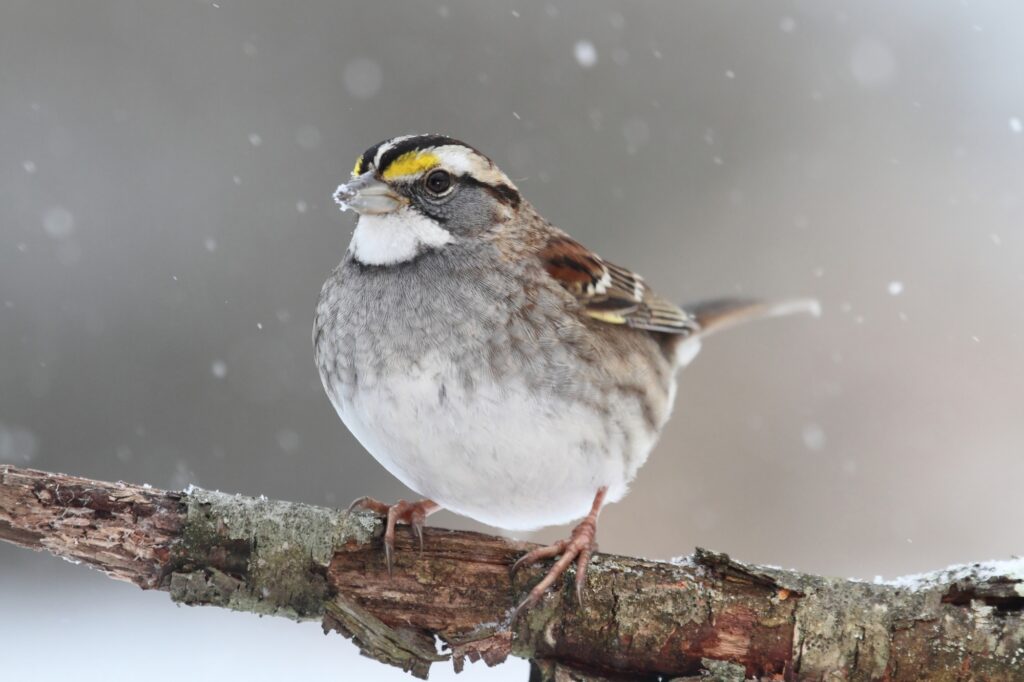You’ve probably seen hundreds – or even thousands – of sparrows in your lifetime. But have you taken the time to identify each of them?
Minnesota hosts many breeding sparrows, as well as some migration stopovers and winter visitors.
According to the Minnesota Department of Natural Resources, a total of 266 species have been recorded nesting in Minnesota. For other birds you might see in Minnesota, click here.
Let’s get to the sparrows, starting with two old-world sparrows.
House Sparrow

- Passer domesticus
- Length: 5.9-6.7 inches
- Weight: 0.9-1.1 ounces
- Wingspan: 7.5-9.8 inches
Our list begins with the house sparrow, a common bird in cities and suburbs across the globe, including North America, where it was first introduced in 1851.
Because of their affinity for human-populated areas, house sparrows are one of the most frequently seen birds by many people. They’ll eat most types of bird seed, but many people don’t like to see them in their yards since they’re non-native birds that have been known to steal food from other birds.
Males are identified by their black bills, throat, and chest, with a chestnut brown back and darker brown side of the head. Females are unremarkable brown sparrows with proportionally large bills.
Eurasian Tree Sparrow
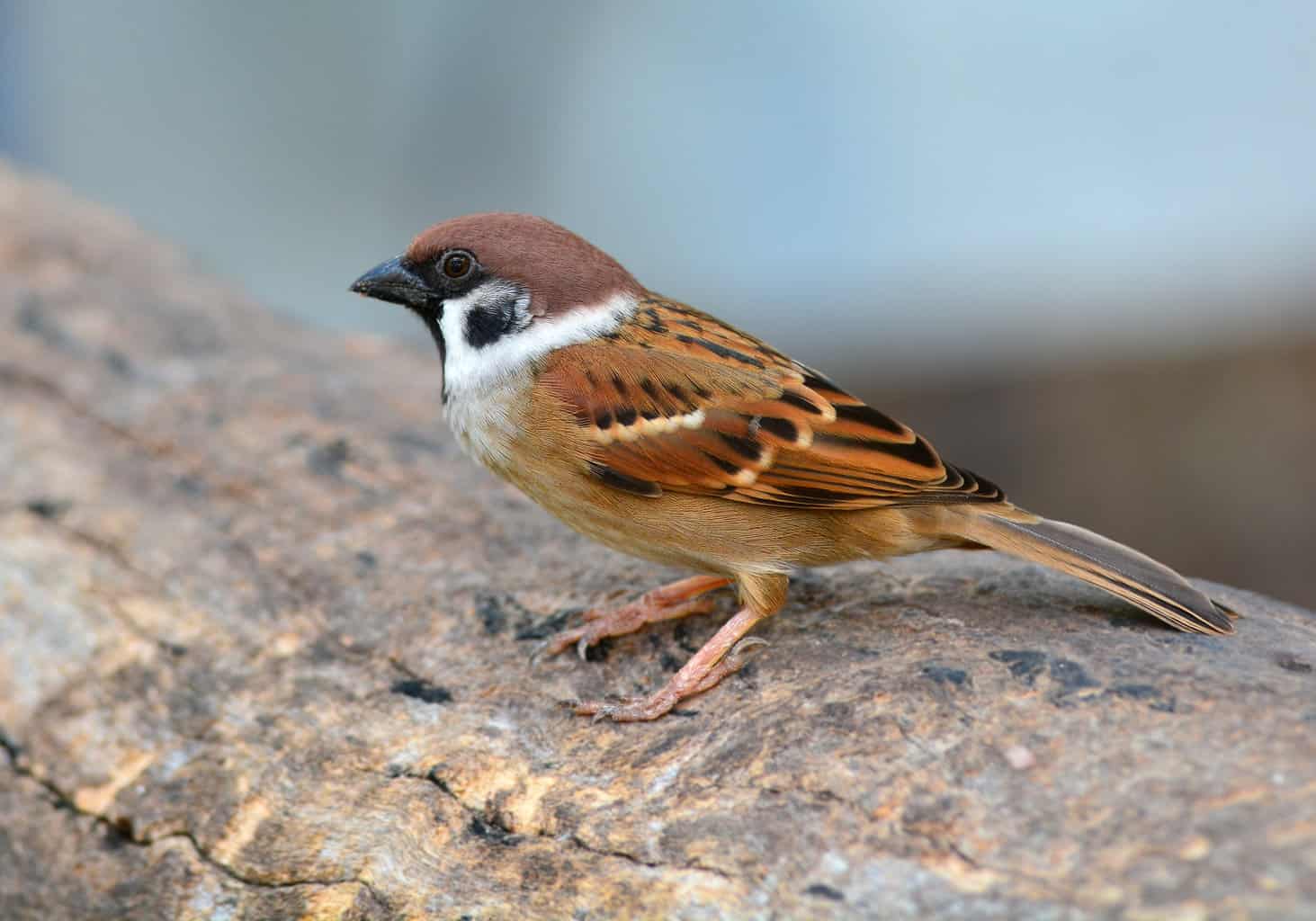
- Passer montanus
- Length: 5.5-5.9 inches
- Weight: 0.6-1.0 ounces
- Wingspan: 7.9-8.7 inches
In 1870, 19 years after the house sparrow was introduced to New York for the first time, 12 Eurasian tree sparrows were released in St. Louis, according to All About Birds.
Eurasian tree sparrows haven’t made their presence felt across the continent in the way house sparrows have, but they’ve been able to stick around and establish a significant population throughout areas of Illinois, Missouri, and Iowa, with sporadic sightings up through surrounding states like Minnesota and Wisconsin.
Like house sparrows, these birds are in the family Passeridae, setting them apart from the North American sparrows of the family Passerellidae.
Both males and females are stocky birds with chocolate brown heads and patterned faces of black and white.
You’re not super likely to see a Eurasian tree sparrow in Minnesota, but if you do, it’s most likely from the Twin Cities and southeast in parks, farmland, and suburb-type areas with some tree cover.
American Tree Sparrow
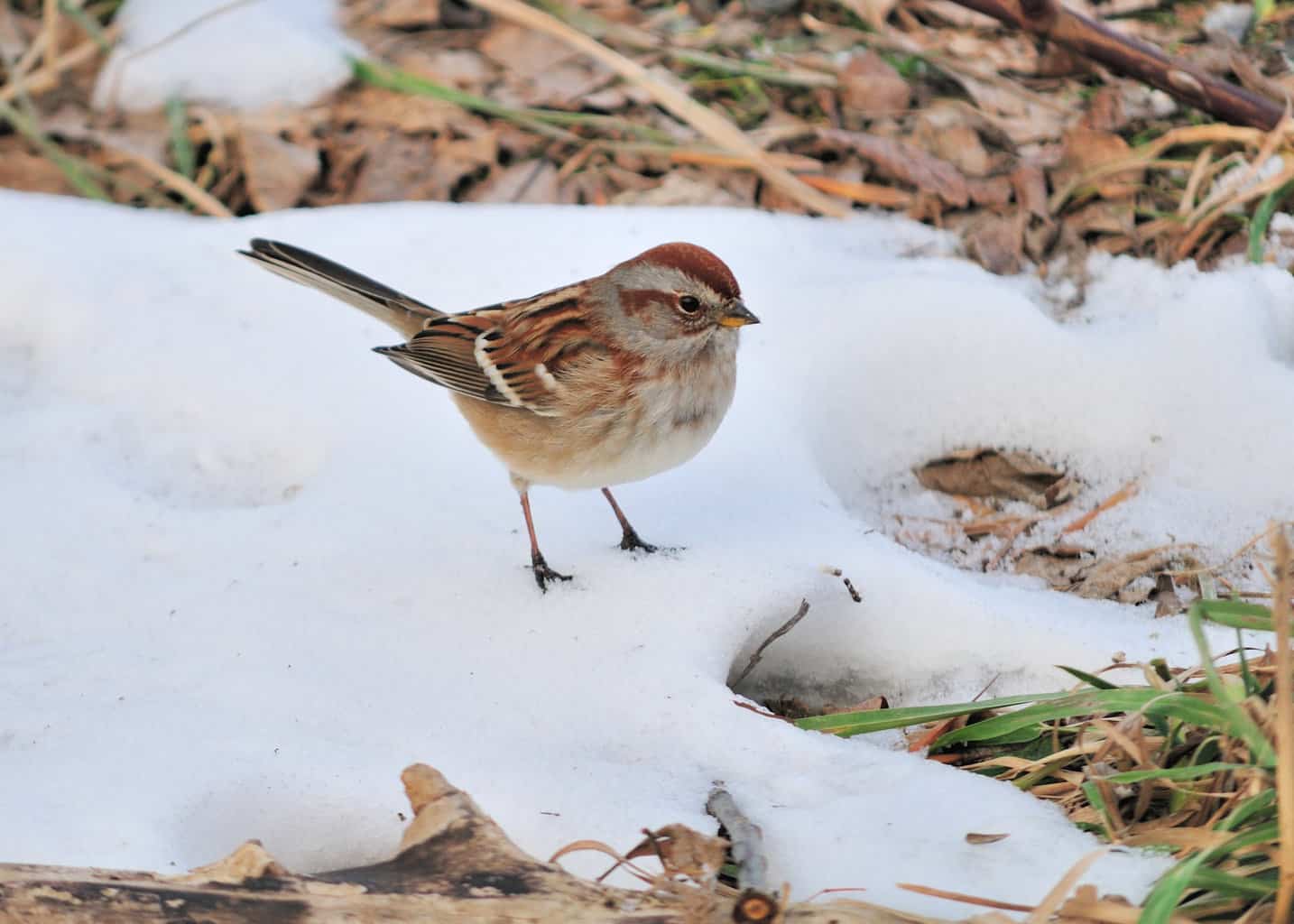
- Spizelloides arborea
- Length: 5.5 inches
- Weight: 0.5-1.0 ounces
- Wingspan: 9.4 inches
American tree sparrows are the first native North American bird on our list, and they’re a common sighting during the winter months.
Much of the United States helps comprise the tree sparrow’s winter range as these birds seek refuge from the harsh winters of their north-Canadian and Alaskan breeding grounds.
American tree sparrows are not aptly-named, as they’re most commonly seen on the ground or in low, dense vegetation like bushes. They will visit bird feeders, including on the ground below.
Their top identifying characteristics are their rusty brown caps and eyelines, as well as a bill that’s black on top and yellow on the bottom and a black spot in the middle of the chest.
Chipping Sparrow
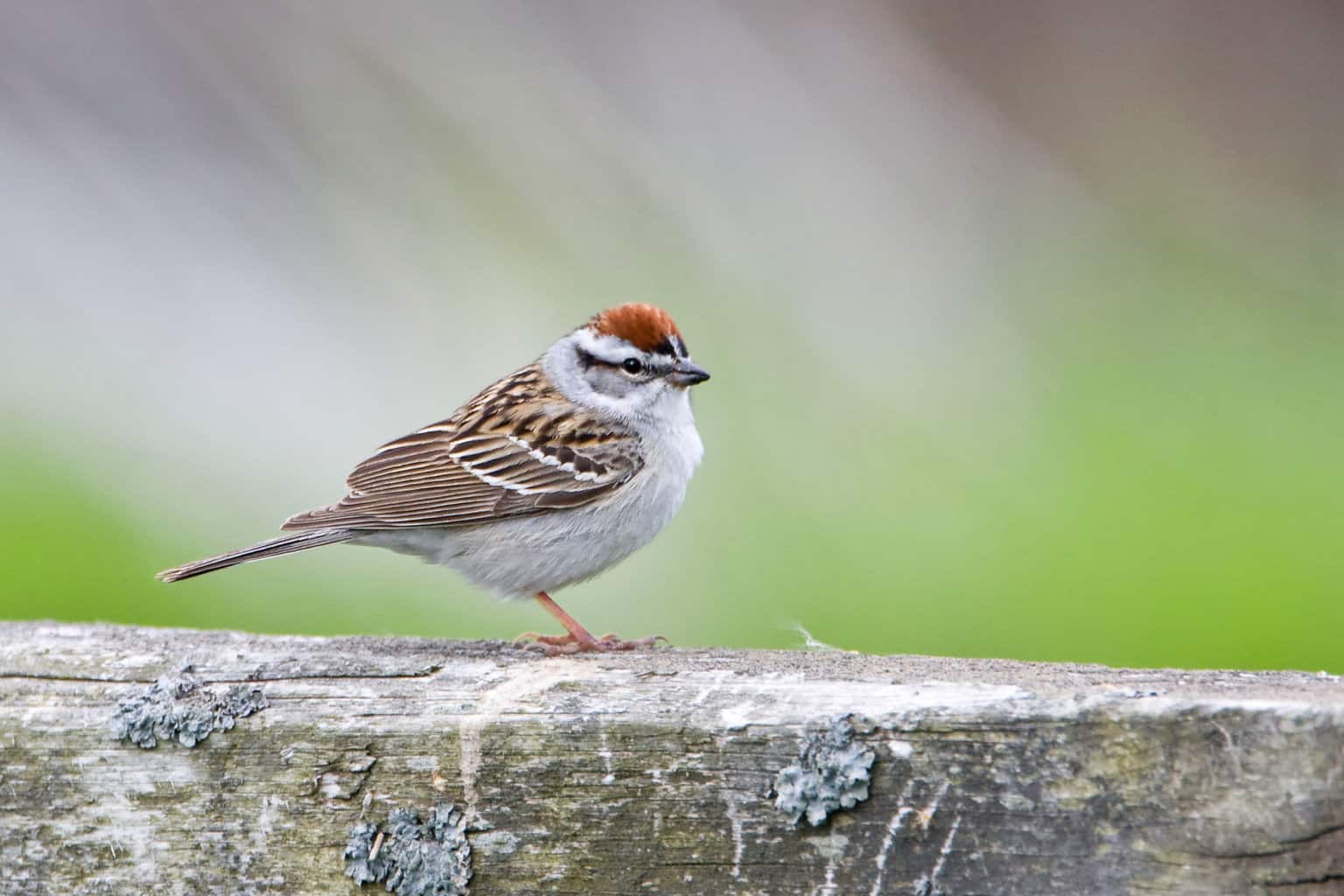
- Spizella passerina
- Length: 4.7-5.9 inches
- Weight: 0.4-0.6 ounces
- Wingspan: 8.3 inches
Breeding chipping sparrows also sport rusty brown caps with a black eyeline.
Both will fade in color into the non-breeding season, but that won’t make much difference for residents of Minnesota, where chipping sparrows are breeding residents.
Chipping sparrows are common sparrows across Minnesota, occupying a multitude of habitats, including parks, fields, and backyards, where you may hear them from shrubs or trees letting out a trilling and melodious song.
Field Sparrow
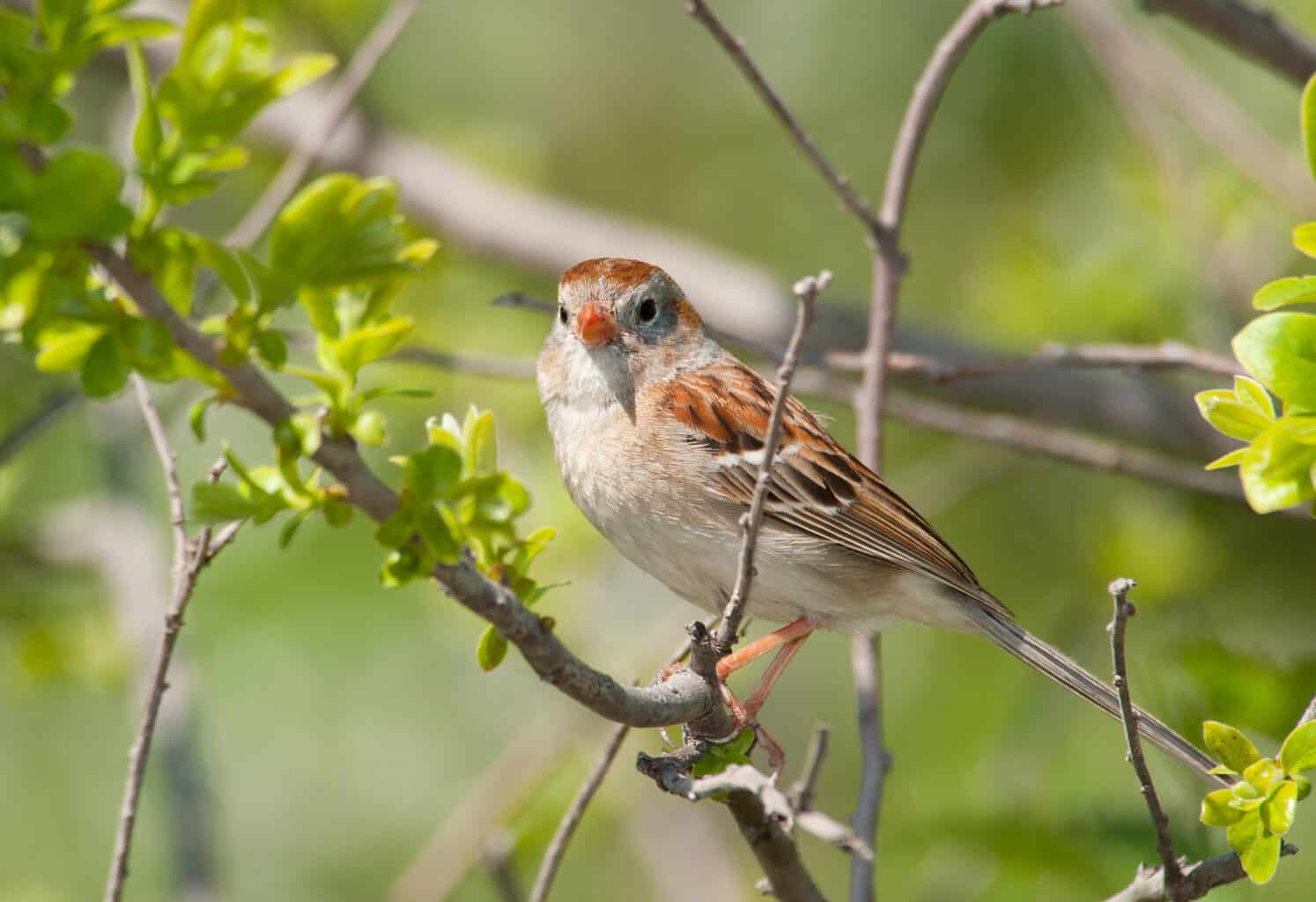
- Spizella pusilla
- Length: 4.7-5.9 inches
- Weight: 0.4-0.5 ounces
- Wingspan: 7.9 inches
The field sparrow’s distinctive song, which starts with longer notes before condensing to a fast trill of short notes in quick succession, is recognizable for many people familiar with grasslands and other shrubby areas.
The field sparrow is a lightly-colored bird, with a tawny brown cap and eyeline coloring, a relatively plain gray underside, and a little pink bill.
Field sparrow sightings start to get more sporadic as you move north through Minnesota, with their main range in the state extending to about the latitude where South Dakota ends and North Dakota begins.
Swamp Sparrow
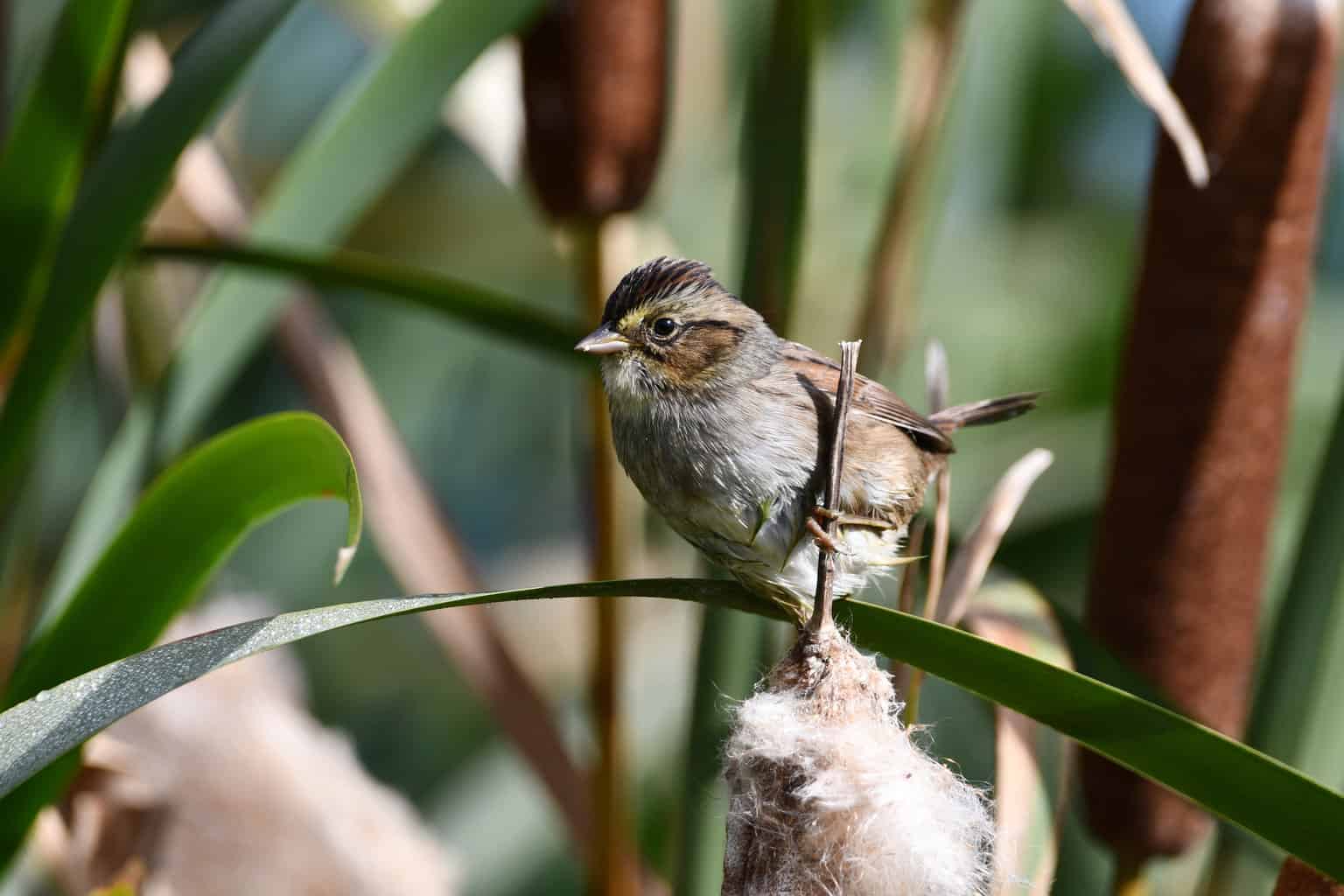
- Melospiza georgiana
- Length: 4.7-5.9 inches
- Weight: 0.5-0.8 ounces
- Wingspan: 7.1-7.5 inches
Minnesota is right in the heart of the swamp sparrow’s range, from the Iowa border up to Canada. These aptly-named sparrows occupy marshes, swamps, and bogs across the state, with the number of confirmed breeders increasing as you move north through the state, according to the Minnesota Breeding Bird Atlas.
They have gray faces with brown streaks over the top of the head and a darker eyeline. Their bill is darker, but not quite black, on the top half, and a lighter yellow color on the bottom.
Lincoln’s Sparrow
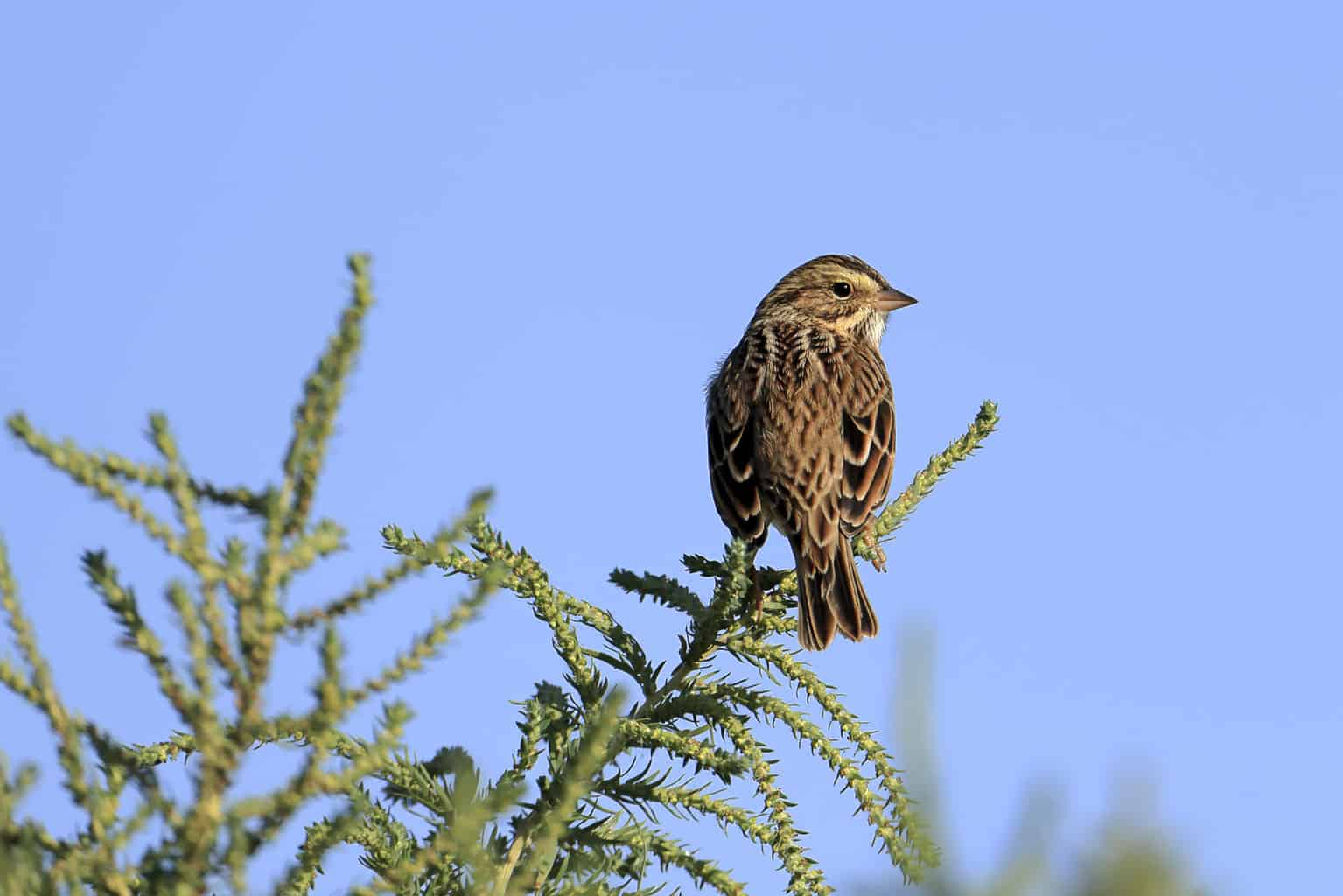
- Melospiza lincolnii
- Length: 5.1-5.9 inches
- Weight: 0.6-0.7 ounces
- Wingspan: 7.5-8.7 inches
Northeastern Minnesota is in the streaky Lincoln’s sparrow’s range, while the rest of the state has the possibility of hosting them as they move north or south during migration to and from their mostly Canadian range.
Lincoln’s sparrows are not often spotted, as they spend much of their time on the ground, scooting through brush or bushes.
When they do make themselves visible, look for a bird with dark streaks from the neck downward that end near the chest before a lighter white belly. They have thicker, darker brown streaks over the top of the head and dark mustache marks working their way out from the bill.
Song Sparrow

- Melospiza melodia
- Length: 4.7-6.7 inches
- Weight: 0.4-1.9 ounces
- Wingspan: 7.1-9.4 ounces
The song of this well-named sparrow fills northern skies each spring, though southern Minnesota may be graced with the song sparrow’s presence all year long.
Unlike some other sparrows, the song sparrow does little to make itself a tough spot, often singing loudly and perching out in the open in several habitat types, including marshes, fields, and backyards.
Song sparrows are streaky brown birds with dark bills. Their numerous thick brown streaks may come to a bigger brown spot in the center of the chest.
Fox Sparrow

- Passerella iliaca
- Length: 5.9-7.5 inches
- Weight: 0.9-1.6 ounces
- Wingspan: 10.5-11.4 inches
Fox sparrows, named for their reddish brown color, are not breeding residents of Minnesota. They’re most likely to just be brief visitors along their migration path.
They’re rather large sparrows, measuring a bit longer than any sparrow we’ve touched on so far. They have yellow and black bills, but their red-brown streaks are their standout identifier. Their streaks aren’t super crisp, almost looking blotchy if you can get a good enough view, such as one through a spotting scope or telephoto lens.
Clay-colored Sparrow
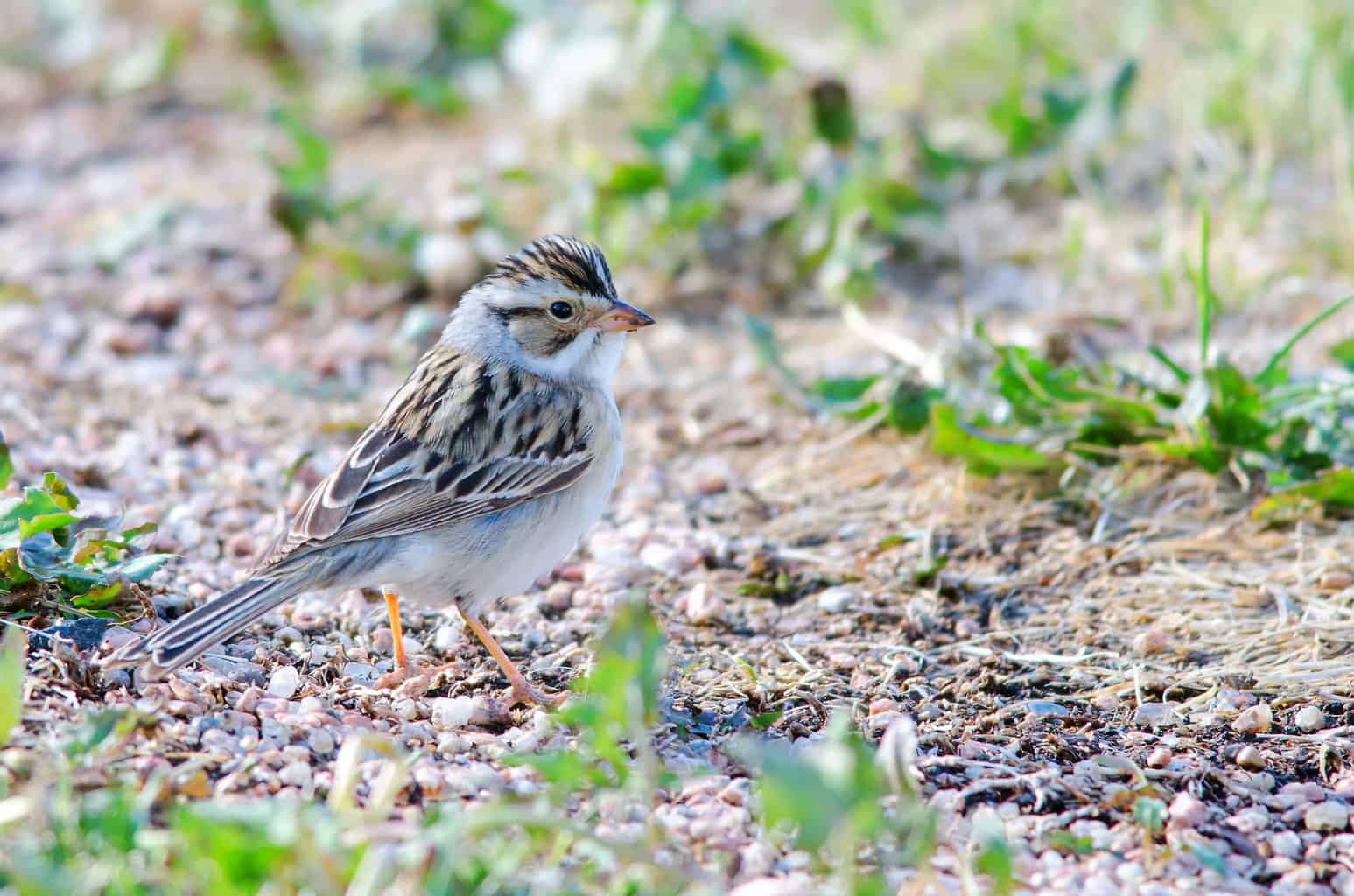
- Spizella pallida
- Length: 5.5 inches
- Weight: 0.42 ounces
- Wingspan: 7.5 inches
(Measurements via The Sibley Guide to Birds)
The clay-colored sparrow’s unique sound could easily be confused with a bug as it releases a series of buzzes from prairies and fields.
Clay-colored sparrows are relatively small birds that feature plain, unstreaked undersides.
Their faces have alternating patches of color, with a darker brown cap and a lighter brown patch of color around the eye, both flanked on each side by a white streak. Their nape is gray.
Clay-colored sparrows are breeding residents of the North Star State, where they occupy grassy areas such as fields with some tree or brush cover.
Savannah Sparrow
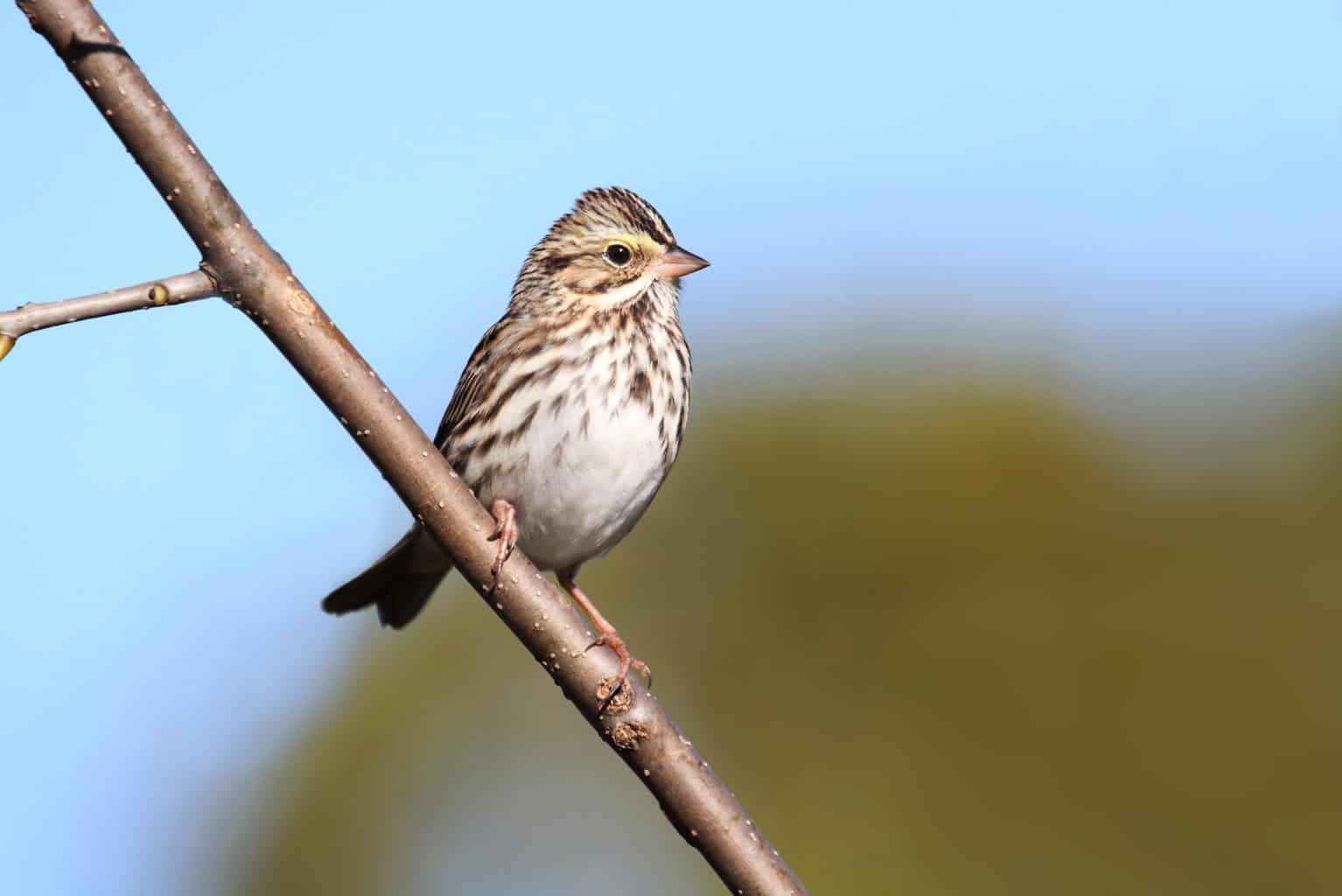
- Passerculus sandwichensis
- Length: 4.3-5.9 inches
- Weight: 0.5-1.0 ounces
- Wingspan: 7.9-8.7 inches
Next up is a common breeding sparrow throughout much of North America, Minnesota included. All of the state is within the Savannah sparrow’s breeding range, but they don’t stick around for the winter months.
Savannah sparrows are streaky brown birds with a signature yellow eyebrow line above and just in front of the eye. They have white bellies and the feathers on the top of their heads may stick up or lay flat.
Savannah sparrows can be found in grasslands, marshes, and agricultural fields bouncing along the ground in search of food.
Grasshopper Sparrow
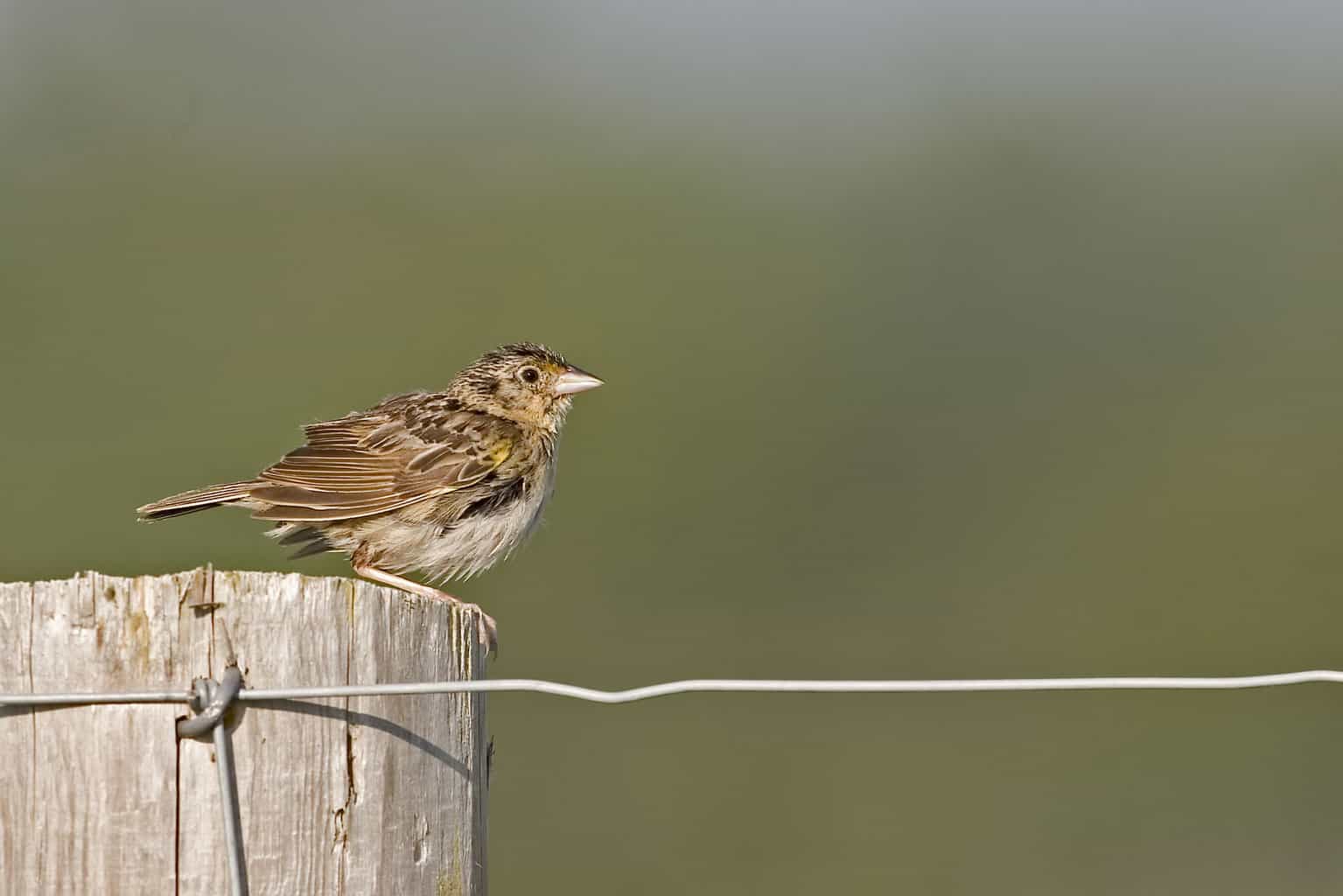
- Ammodramus savannarum
- Length: 4.3-4.5 inches
- Weight: 0.5-0.7 ounces
- Wingspan: 7.9 inches
Grasshopper sparrows also have a little yellow mark above the eye like Savannah sparrows, but with unstreaked undersides that easily set them apart.
Most of Minnesota could host grasshopper sparrows during the summer months when they inhabit grasslands and farm fields. The only residents of the state that likely won’t see them each year are those in the northeast corner of the state, though there is an occasional sighting here and there from eBird users.
They don’t spend much time in the air, instead moving around cover on the ground. If you hear one, keep your eyes trained low to give yourself the best chance of seeing it.
Baird’s Sparrow
- Centronyx bairdii
- Length: 4.7-5.5 inches
- Weight: 0.5-0.8 ounces
- Wingspan: 8.7-9.1 inches
The Baird’s sparrow has been considered endangered in Minnesota since 1984, according to the Minnesota Department of Natural Resources, which states that the birds have been observed in the Felton Prairie area in Clay County in only three summers since 1990, with no confirmed nesting.
Baird’s sparrows feature yellowish coloring on their faces, with a buffy patch near the cheek. They have white, unstreaked bellies and short brown streaks around the neck and upper chest.
LeConte’s Sparrow
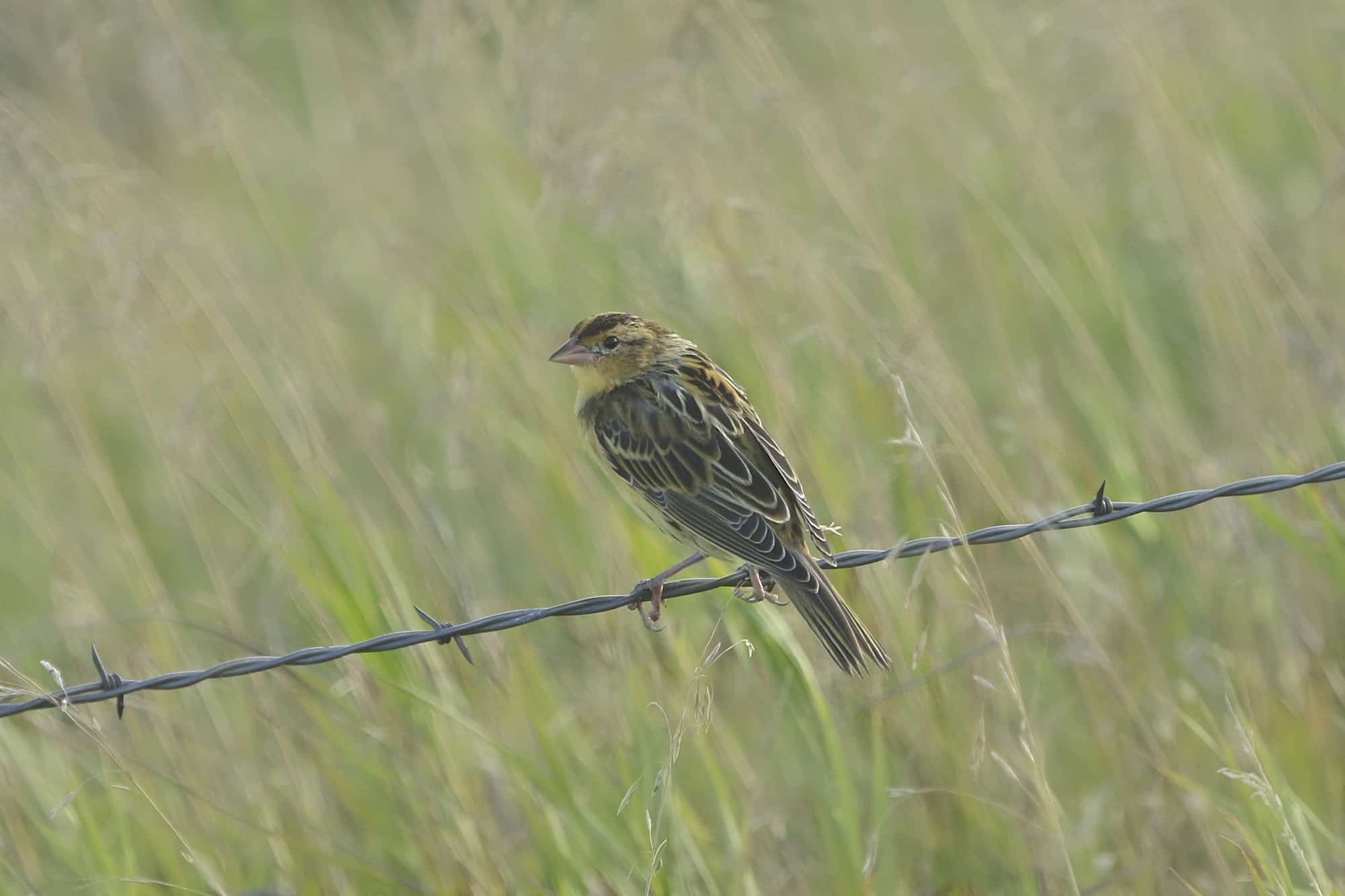
- Ammospiza leconteii
- Length: 4.7-5.1 inches
- Weight: 0.4-0.6 ounces
- Wingspan: 6.3-7.1 inches
LeConte’s sparrow populations declined by about 2.6 percent per year between 1966 and 2015, according to the North American Breeding Bird Survey, but their Minnesota numbers have stayed relatively flat, at about a .24 percent-per-year decline. Still, they’re not a super common report from eBird users.
They prefer dense, wet habitats with few or no trees. The bulk of their breeding range is in north-central Canada, with northern Minnesota, Wisconsin, and Michigan comprising their range’s southernmost reaches.
LeConte’s sparrows are relatively unmarked on their undersides, with a yellowish tint throughout the face and a dark eyeline that widens out as it moves toward the back of the head.
Henslow’s Sparrow
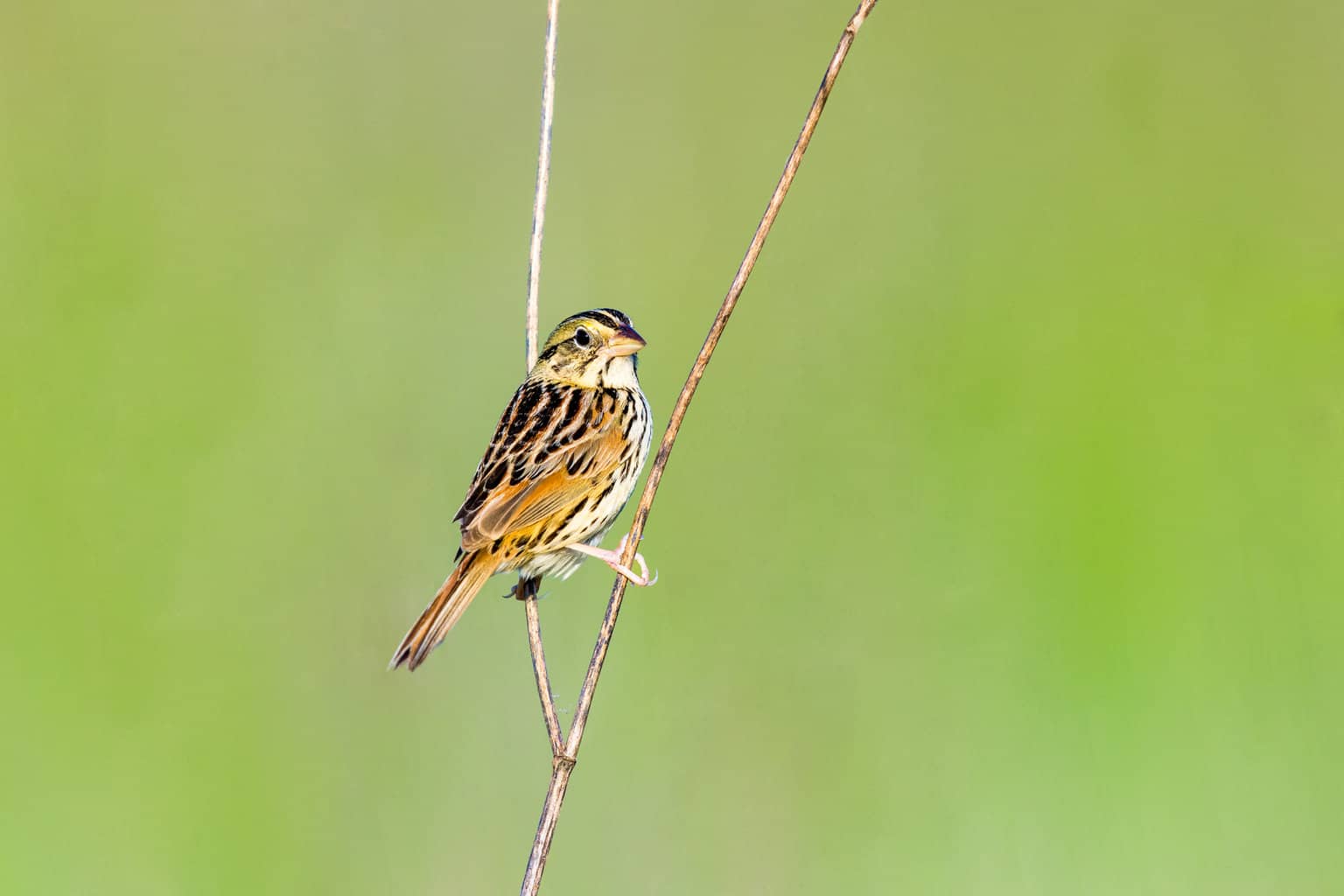
- Centronyx henslowii
- Length: 4.3-5.1 inches
- Weight: 0.4-0.5 ounces
- Wingspan: 6.3-7.9 inches
Henslow’s sparrows have short, dotted streaks on their chests, black mustache markings, and bulky bills.
They’re ground feeders of thick grassland cover, making them infrequently seen birds.
Most sightings of Henslow’s sparrows in Minnesota come from the southeastern corner of the state during the breeding months.
Some sites that have produced multiple eBird sightings in recent years include Chester Woods west of Rochester and Myre Big Island State Park near Albert Lea.
Nelson’s Sparrow
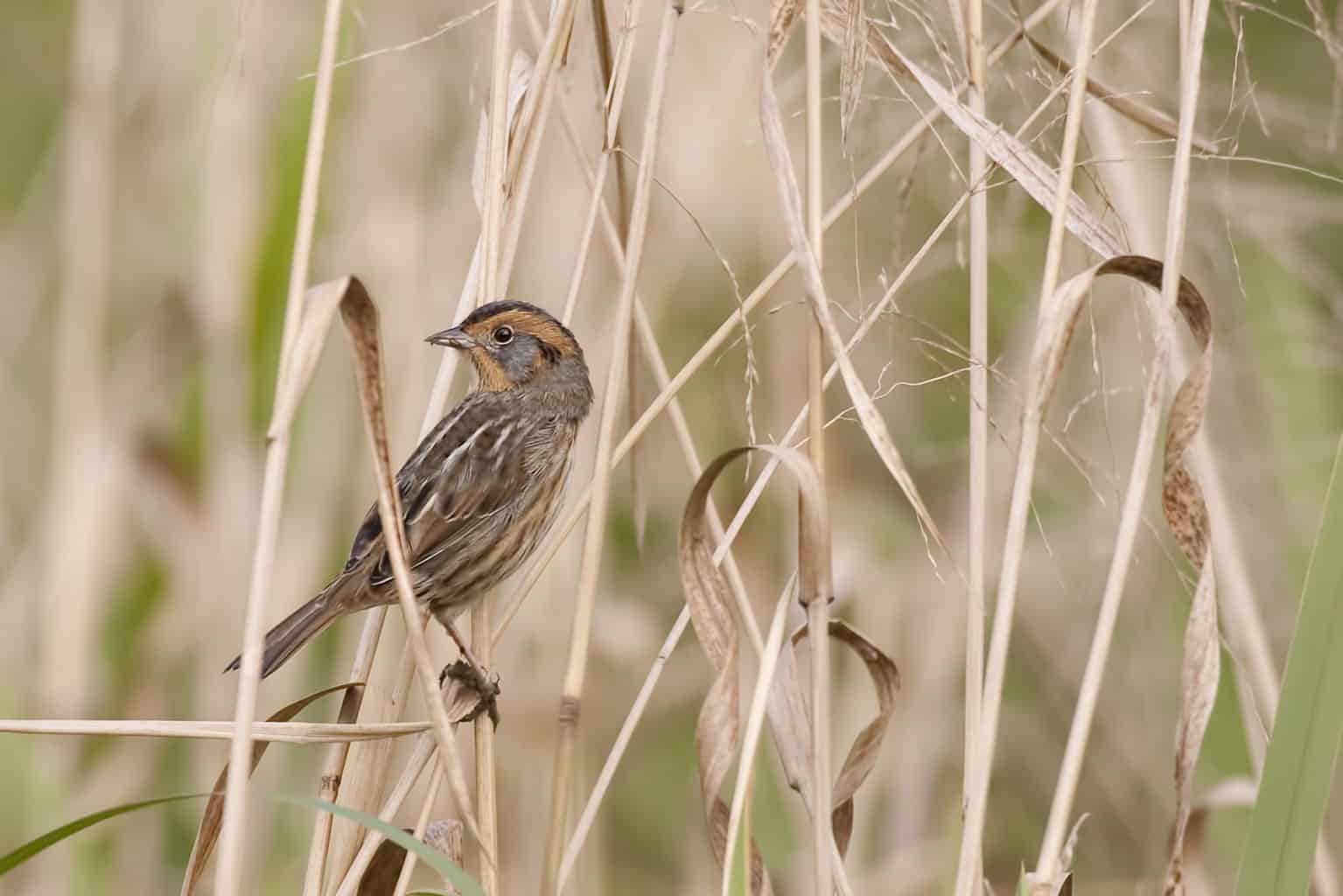
- Ammospiza nelsoni
- Length: 4.3-5.1 inches
- Weight: 0.6-0.7 ounces
- Wingspan: 6.5-7.9 inches
An uncommon Minnesota sighting, Nelson’s sparrows are migratory visitors for most of the state, except for northwestern and north-central areas of the state, where they may spend the summer in marshes, wetlands, and other wet habitats.
According to the Minnesota Department of Natural Resources, this species is partial to sedge wetlands and is very sensitive to changes in water levels like drainage and impoundments.
Nelson’s sparrows have an orangish-yellow color to them, with light streaking on their undersides. Their nape is gray, and they feature a small gray patch under the eye as well. Nelson’s sparrows in interior areas like Minnesota tend to feature more defined brown and orange coloring than Nelson’s sparrows in other locations.
Vesper Sparrow
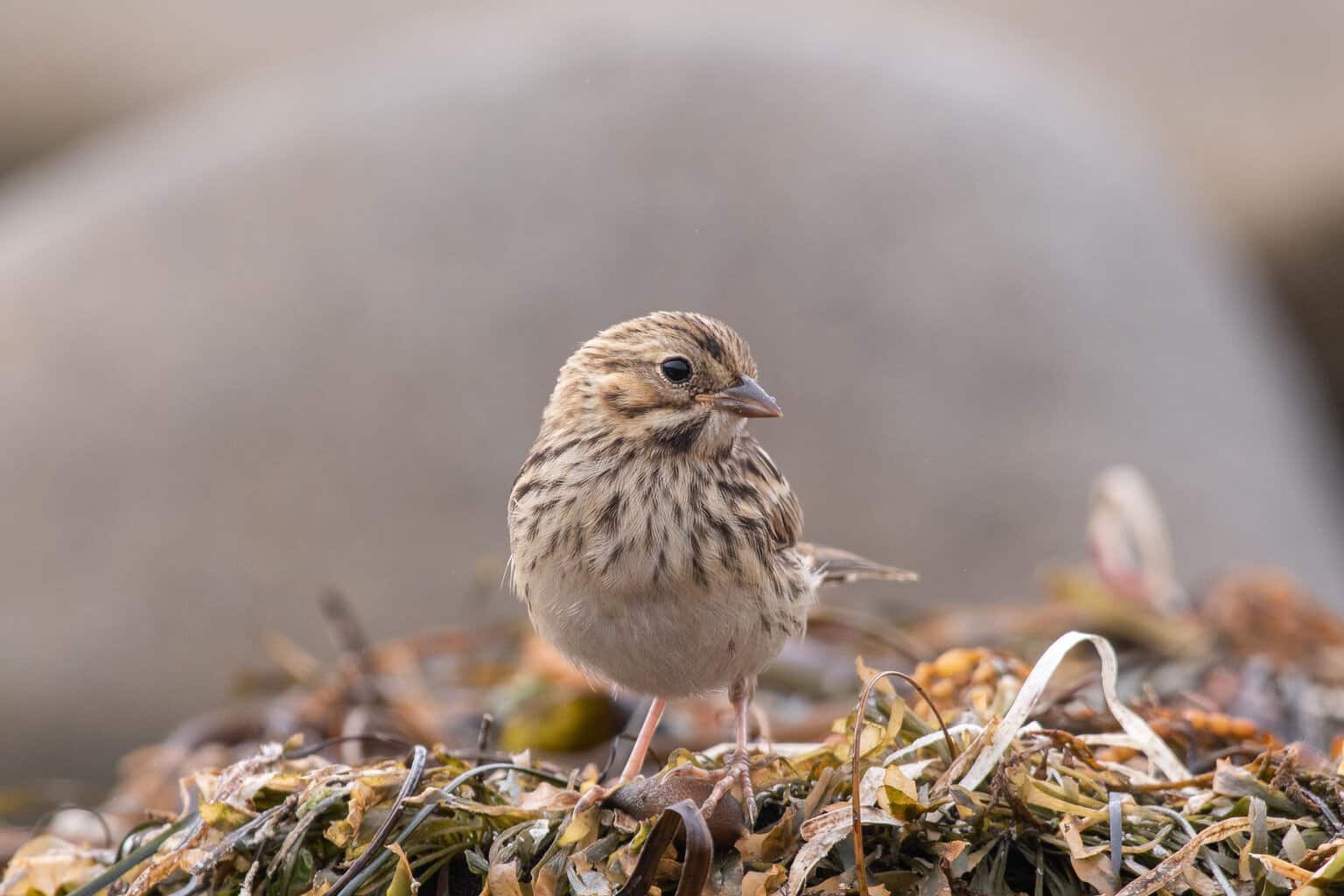
- Pooecetes gramineus
- Length: 5.1-6.3 inches
- Weight: 0.7-1.0 ounces
- Wingspan: 9.4 inches
Vesper sparrows are regular breeders in Minnesota. During the Minnesota Breeding Bird Atlas from 2009 to 2013, they were common, with some birds even staying into the early winter.
They were rare in the northeastern corner of the state, but they could be found in much of the rest of the state, where they take up residence in grasslands. The vesper sparrow is the only member of its genus, Pooecetes, meaning grass dweller.
Vesper sparrows have brown streaking on the chest before a white belly and a white eye ring.
Lark Sparrow
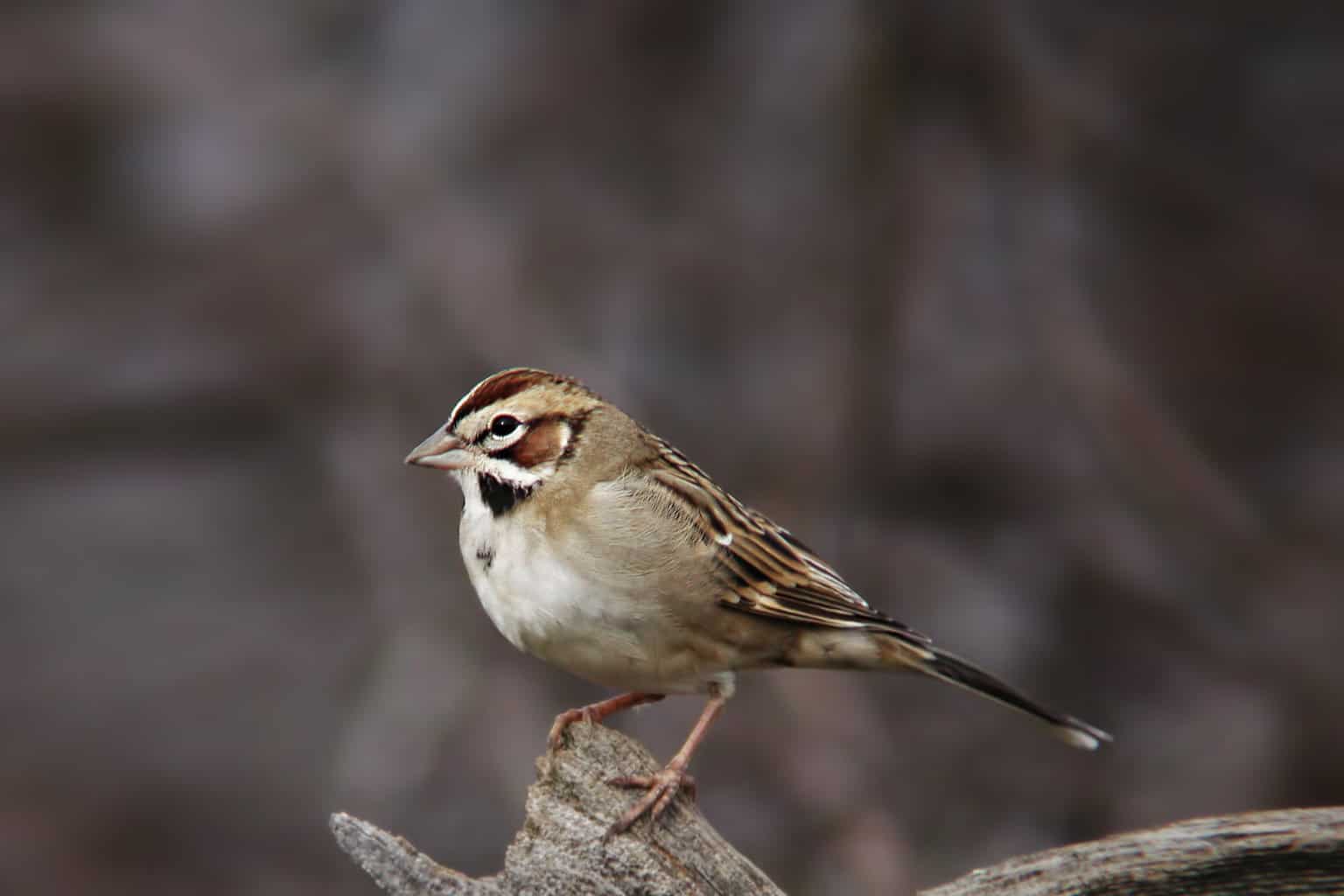
- Chondestes grammacus
- Length: 5.9-6.7 inches
- Weight: 0.8-1.2 ounces
- Wingspan: 11.0 inches
The lark sparrow’s range map doesn’t paint the picture of a common North Star State bird, with its breeding range barely reaching into Minnesota along the western and southeastern borders.
They live in oak savanna and dry prairie habitats. Minnesota has lost most of that habitat type, though that’s not a problem unique to Minnesota.
Lark sparrows have striking, recognizable patterns, with a central black splotch in the middle of the breast and a face that alternates between chocolate brown, black, and white.
Harris’s Sparrow
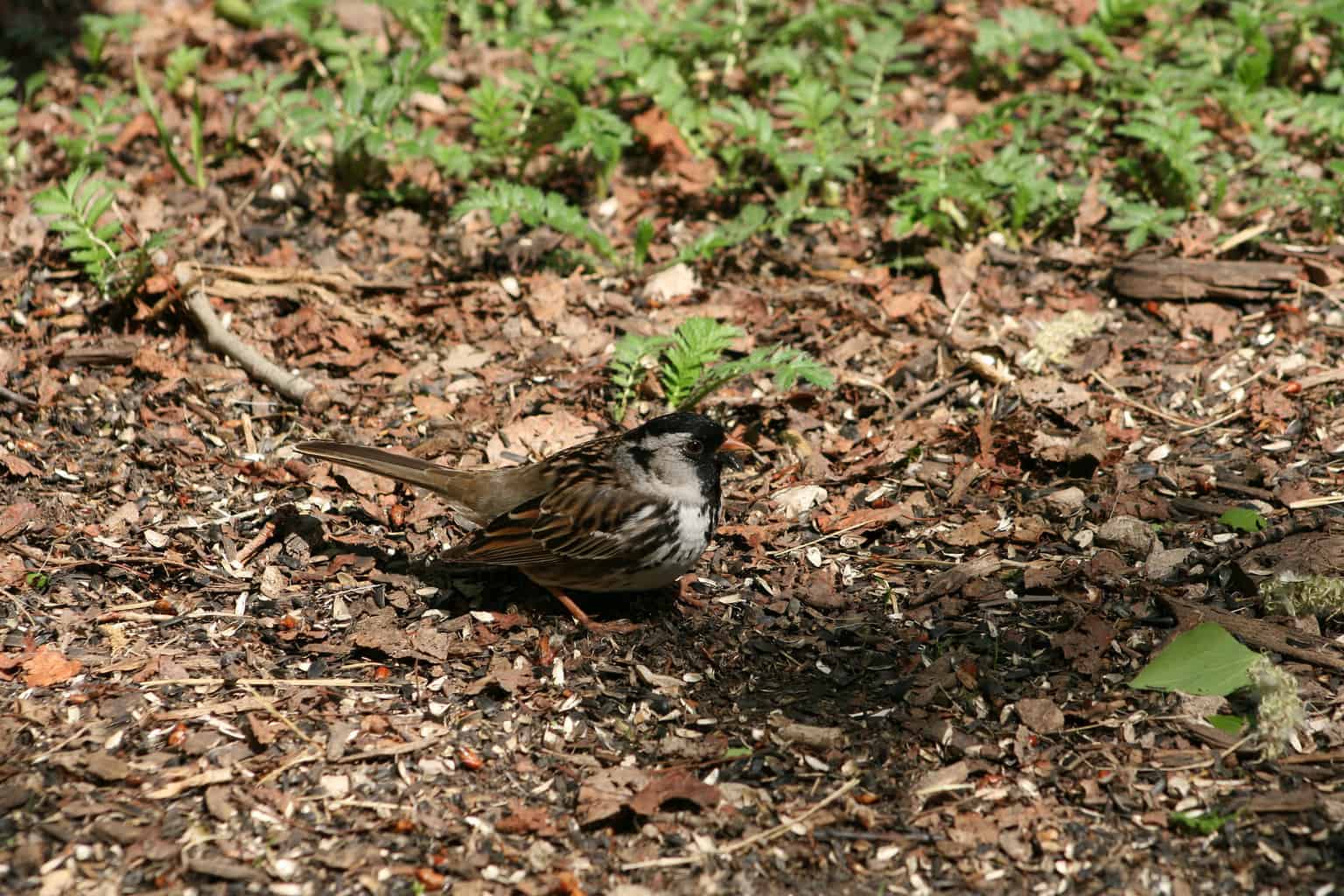
- Zonotrichia querula
- Length: 6.7-7.9 inches
- Weight: 0.9-1.7 ounces
- Wingspan: 10.6 inches
Speaking of sparrows with a signature look, the next bird on our list features a black face and bib with gray across the rest of the head, unlike any other sparrow.
Under its black bib are a white chest and belly with limited streaking on the flanks of its underside.
They have a fairly restricted range in central North America. Look for them as they pass through on their yearly migration routes from wintering grounds in Nebraska, Kansas, Oklahoma, and Texas to their northern Canadian breeding areas.
White-crowned Sparrow
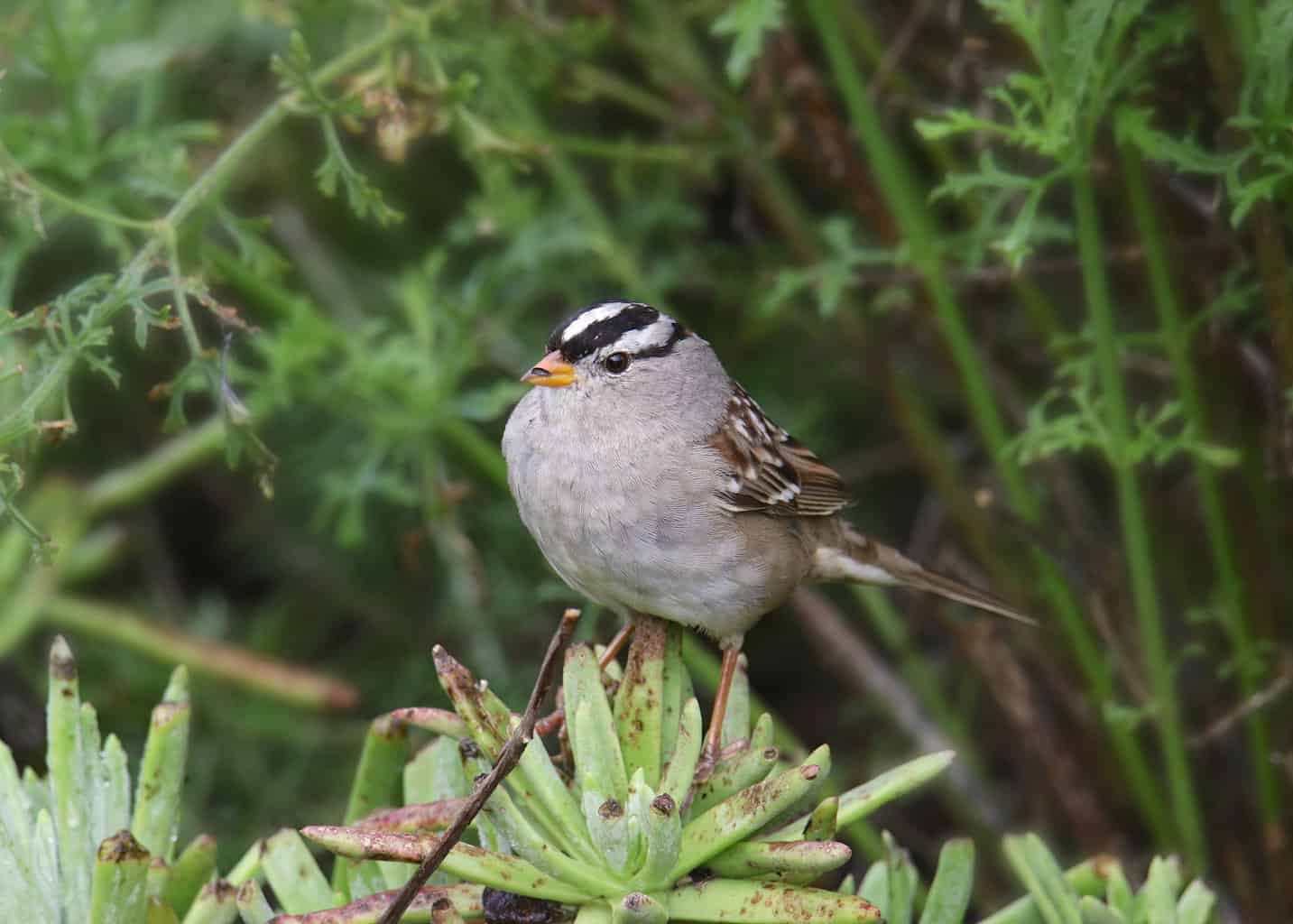
- Zonotrichia leucophrys
- Length: 5.9-6.3 inches
- Weight: 0.9-1.0 ounces
- Wingspan: 8.3-9.4 inches
White-crowned sparrows visit the upper Midwest in groups each spring and fall as they migrate, popping up at backyard feeders for a short while before moving on.
They’re another bird with a distinctive look. Their napes and chests are all gray, but after a black eyeline, their heads are covered in alternating white and black stripes.
White-throated Sparrow
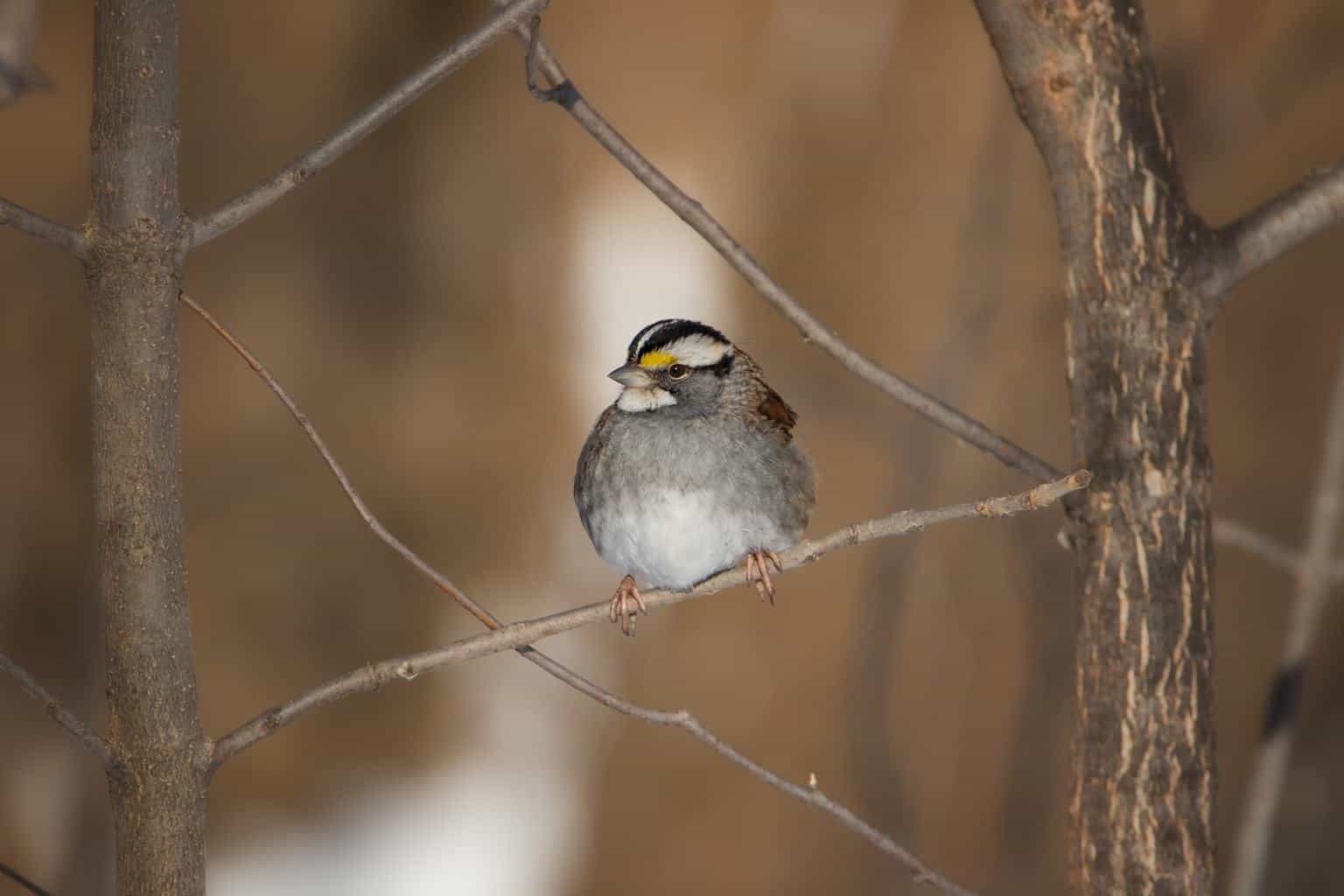
- Zonotrichia albicollis
- Length: 6.3-7.1 inches
- Weight: 0.8-1.1 ounces
- Wingspan: 7.9-9.1 inches
White-throated sparrows were concentrated in northern Minnesota during the Minnesota Biological Survey of bird locations, especially in the state’s northeastern corner.
Their penchant for northern Minnesota is one hint about their preferred habitat, as they tend to frequent forests.
White-throated sparrows are beautiful birds, sporting white chins flanked by black lines, as well as gray chests, black and white streaked heads, and bright yellow markings in front of the eyes.
Dark-eyed Junco
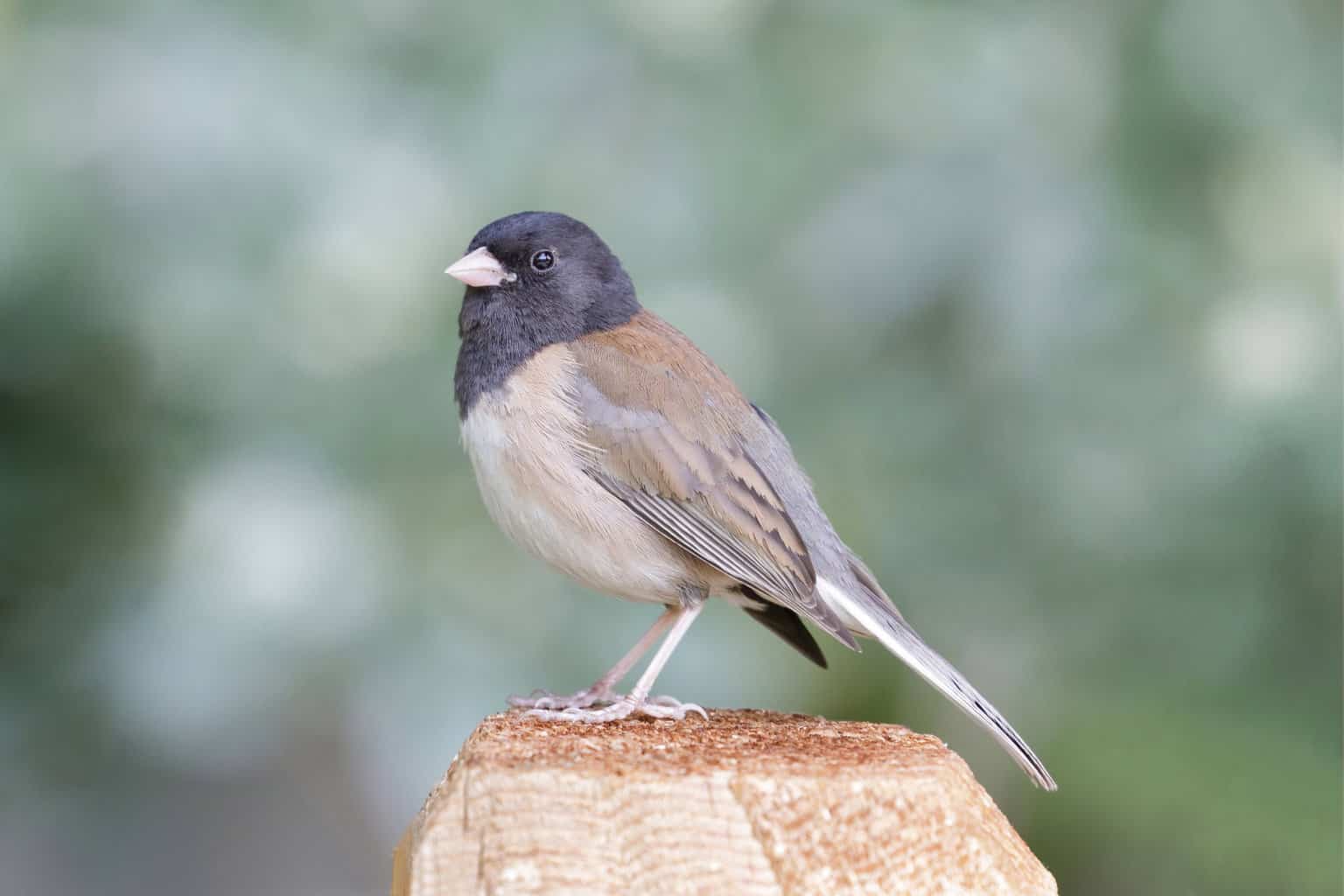
- Junco hyemalis
- Length: 5.5-6.3 inches
- Weight: 0.6-1.1 ounces
- Wingspan: 7.1-9.8 inches
Many in the Midwest think of dark-eyed juncos as a sign of either winter’s upcoming arrival when they arrive for the winter or the start of spring when they leave for northern breeding grounds each year. However, residents of northern Minnesota, Michigan, and Wisconsin are used to seeing these plump little sparrows all year.
They’re commonly seen bouncing around the floors of forests of the north and below feeders in people’s yards throughout the country during the winter months.
The slate-colored variety, the one seen in Minnesota, features a body that’s mostly slate gray with a white belly. They have black eyes and light-colored bills.
Eastern Towhee

- Pipilo erythrophthalmus
- Length: 6.8-8.2 inches
- Weight: 1.1-1.8 ounces
- Wingspan: 7.9-11.0 inches
You likely wouldn’t confuse eastern towhees with any other sparrow on this list. Between their striking color patterns and their size, generally larger than most sparrows, they’re in a class of their own.
Males feature black backs, heads, and chests, white bellies, and bronzed orange sides. Females have a similar appearance, but substitute brown for the males’ black.
Another similar towhee species, the spotted towhee, is rarer in the Midwest.
Listen and look for towhees along thickets and forest edges and clearings. They’re most common as breeders on a belt that cuts across the middle of Minnesota from the southeastern corner, up along the Mississippi River, and through to the northwestern corner of the state, with their breeding range mostly excluding northeastern Minnesota.
Most observations of breeding in southwestern Minnesota during the state’s Breeding Bird Atlas (2009-2013) followed the Minnesota River.
Spotted Towhee
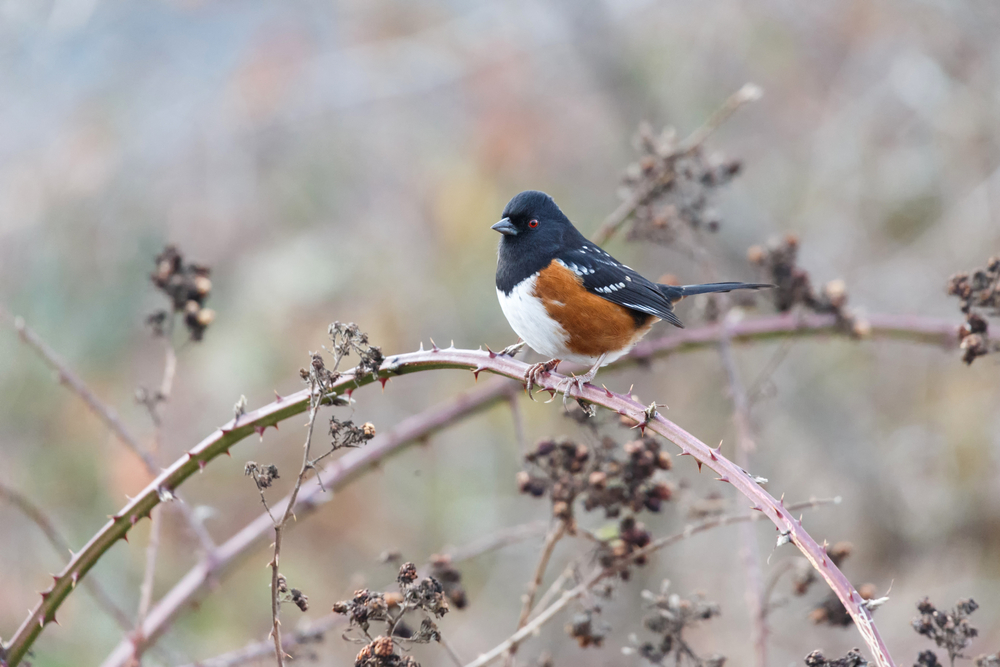
- Pipilo maculatus
- Length: 6.7-8.3 inches
- Weight: 1.2-1.7 ounces
- Wingspan: 11 inches
As mentioned earlier, the spotted towhee is quite rare in Minnesota, but there are sightings each year within its borders.
Like eastern towhees, they have orange sides, white bellies, and black or brown everywhere else, with spotting along the wings and back.
Keep your ear to the pulse of local birding groups and eBird if you’re hoping to get the drop on any spotted towhee hanging around in the North Star State.

